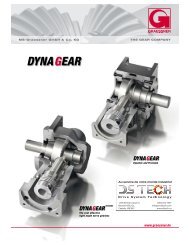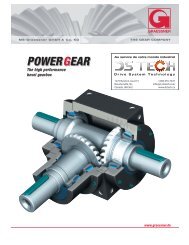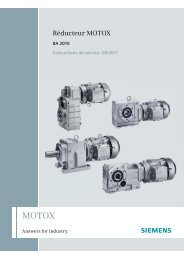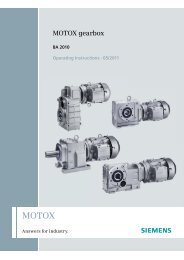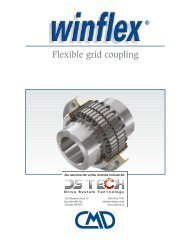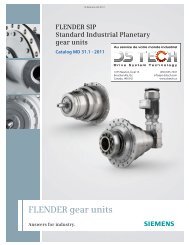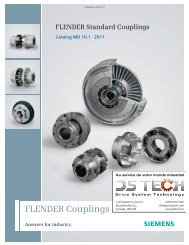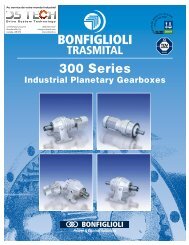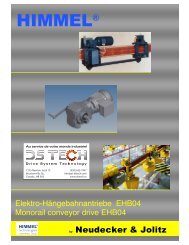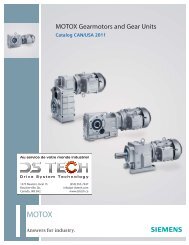Create successful ePaper yourself
Turn your PDF publications into a flip-book with our unique Google optimized e-Paper software.
®<br />
Schneckenradsätze Worm and Wheel Sets Couples avec vis sans fin<br />
Technische Hinweise Technical Instructions Instructions techniques<br />
1. Nacharbeiten der Schneckenschäfte<br />
Beim Nacharbeiten der Schneckenschäfte muß<br />
der Rundlauf erhalten bleiben. An den Richtstellen<br />
dürfen Rundlauffehler von max. 0,02 bis<br />
0,04 mm – je nach Radsatzgröße – keinesfalls<br />
überschritten werden.<br />
2. Aufsetzen des Radkranzes<br />
Der Radkranz ist vor dem Aufsetzen anzuwärmen.<br />
Die Temperaturdifferenz zum Radkörper<br />
muß mindestens 50 °C betragen. Danach sind<br />
die Paßschraubenlöcher von Kranz und Körper<br />
gemeinsam aufzureiben und die Paßschrauben<br />
von der Kranzseite her durchzuführen. Wichtig<br />
ist, daß Scheiben auf den Radkranzsteg gelegt<br />
werden.<br />
Die Paßschraubenverbindung ist zu sichern. Das<br />
Ver<strong>kl</strong>eben des Gewindes mit Flüssigkunststoffen<br />
hoher Festigkeit hat sich bewährt. Die Paßschraubenverbindung<br />
ist mit folgenden Drehmomenten<br />
anzuziehen:<br />
1. Finishing work on worm shafts<br />
Finishing work on worm shafts must be carried<br />
out with the greatest care to ensure proper concentricity.<br />
Depending on the worm and wheel set<br />
size, radial runout on the reference points must<br />
not exceed 0.02 to 0.04 mm.<br />
2. Fitting the wheel rim<br />
Before fitting, the wheel rim should be heated to<br />
have a temperature difference of at least 50 °C to<br />
the wheel hub. Then, the close fitting bolt holes<br />
of wheel rim and wheel hub should be reamed<br />
together and the close fitting bolts inserted from<br />
the rim side. It is essential that washers are placed<br />
under the bolt heads on the wheel web.<br />
The close fitting bolt connection should be secured.<br />
The use of high-tensile liquid plastics has<br />
proved very reliable. The close fitting bolts and<br />
nuts should be tightened with the following<br />
torques:<br />
1. Finitions des bouts d’arbre de vis<br />
Lors d’usinage de finition des arbres de vis la concentricité<br />
doit être conservée. Sur les portées de<br />
référence le défaut de concentricité doit obligatoirement<br />
rester en dessous de 0.02 à 0.04 mm selon<br />
la taille du couple.<br />
2. Montage de la couronne<br />
La couronne doit être chauffée avant son montage.<br />
La différence de température doit être d’au<br />
moins 50 °C par rapport au corps de roue.<br />
Par la suite les perçages pour les boulons ajustés<br />
entre la couronne et le corps de roue sont à aléser.<br />
Les têtes des boulons ajustés doivent êtres<br />
positionnées côté couronne. Il est important que<br />
des rondelles soient placées sur la nervure de la<br />
couronne.<br />
La liaison par boulons ajustés doit etre sécurisée.<br />
Le collage à haute résistance des filets a fait ses<br />
preuves les boulons ajustés sont à serrer avec les<br />
couples suivantes:<br />
Paßschraube<br />
Festigkeits<strong>kl</strong>asse<br />
Close fitting bolt<br />
Property class<br />
Classe de résistance<br />
des boulons ajustés<br />
88 8.8<br />
10.99<br />
Gewinde<br />
Thread<br />
Filetage<br />
entölt<br />
oil removed<br />
dégraissé<br />
geölt<br />
oiled<br />
non dégraissé<br />
entölt<br />
oil removed<br />
dégraissé<br />
geölt<br />
oiled<br />
non dégraissé<br />
M 8 M 10 M 12 M 14 M 16 M 20 M 24 M 30<br />
Anziehdrehmoment in Nm<br />
Tightening torque in Nm<br />
Couple de serrage en Nm<br />
30 60 105 165 255 500 870 1750<br />
25 49 86 135 210 410 710 1450<br />
40 84 145 230 360 710 1200 2450<br />
35 69 120 190 295 580 1000 2000<br />
Die Festigkeits<strong>kl</strong>asse 10.9 ist bei hohen Belastungen<br />
erforderlich.<br />
3. Einbau der Schnecke<br />
Bei einer Lagerung entsprechend Bild 57.I ist je<br />
nach Größe ein Axialspiel von 0,04 bis 0,14 mm<br />
vorzusehen. Im warmgelaufenen Zustand soll die<br />
Lagerung spielfrei sein, wobei die Schnecke<br />
leicht von Hand drehbar sein soll.<br />
Bei einer Lagerung entsprechend Bild 57.2 ist für<br />
Lager mit Bohrungen von 50 bis 150 mm ein axiales<br />
Spiel von ca. 0,1 bis 0,25 mm vorzusehen.<br />
Property class 10.9 is required in case of high<br />
loads.<br />
3. Fitting the worm shaft<br />
Depending on the size, an axial clearance between<br />
0.04 and 0.14 mm has to be provided for a<br />
bearing arrangement according to fig. 57.1. In<br />
warm condition this clearance should be reduced<br />
to zero, but the worm should be easily rotatable by<br />
hand.<br />
For a bearing arrangement according to fig. 57.2,<br />
an axial clearance of approx. 0.1 to 0.25 mm<br />
should be provided for bearings with bore diameters<br />
between 50 and 150 mm.<br />
La classe de résistance 10.9 est nécessaire en<br />
cas de fortes charges.<br />
3. Montage de la vis<br />
Lors d’un montage sur roulements selon la figure<br />
57.1 il est nécessaire de prévoir un jeu axial de<br />
0,04 à 0,14 mm. Au niveau du fonctionnement à<br />
chaud, les roulements doivent être sans jeu mais<br />
la vis doit toutefois tourner librement à la main.<br />
Lors d’un montage sur roulements selon le figure<br />
57.2, il est à prévoir pour les alésages de 50 à<br />
150 mm un jeu axial d’environ 0,1 à 0,25 mm.<br />
57.1 57.2<br />
K882 DE/EN/FR<br />
(450) 655-7447<br />
info@pt-dstech.com<br />
www.dstech.ca<br />
1275 Newton, local 15<br />
Boucherville, Qc,<br />
Canada, J4B 5H2<br />
57



